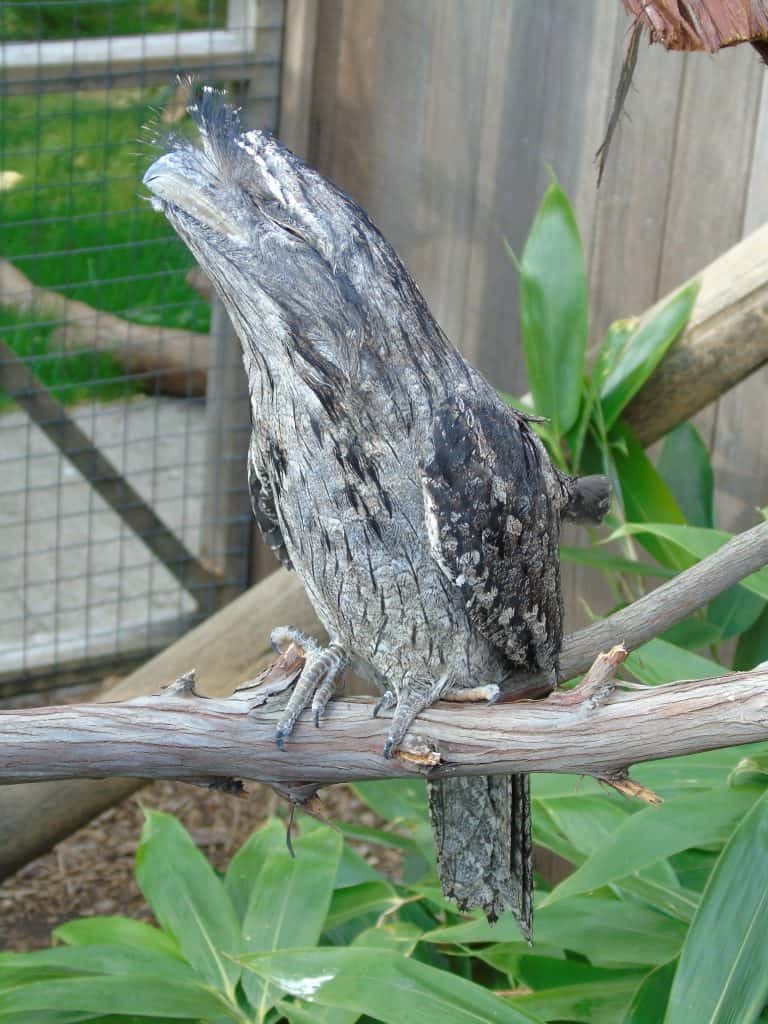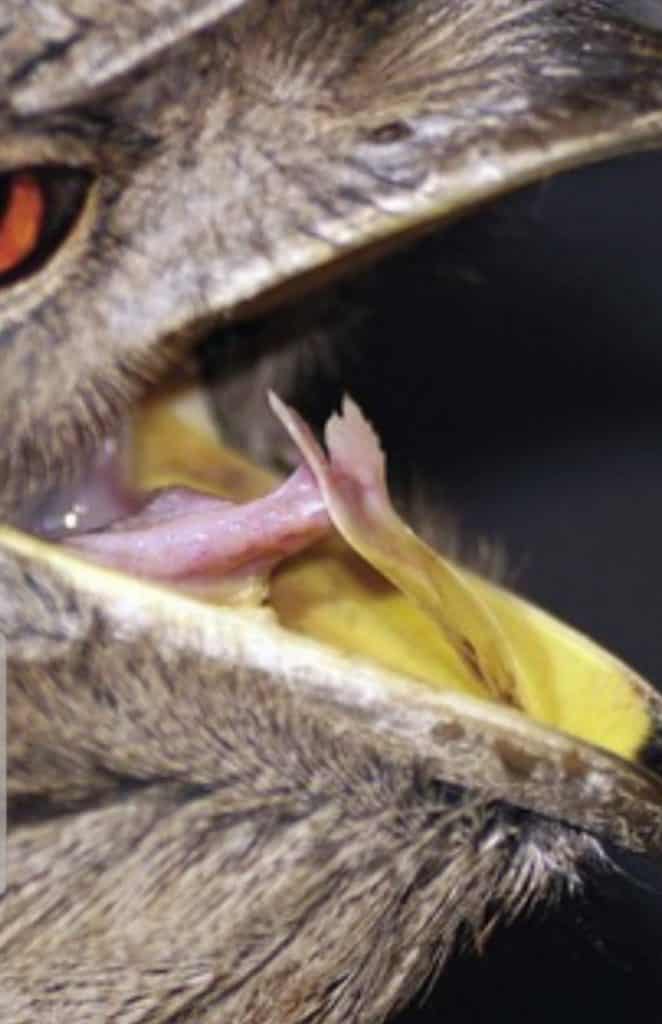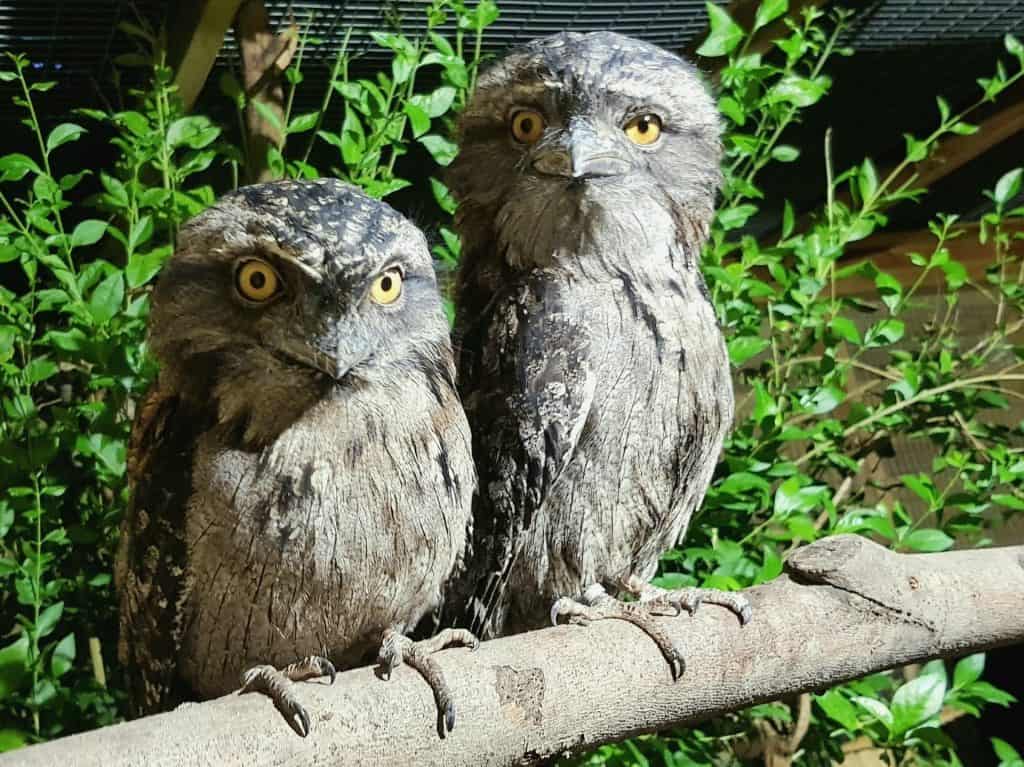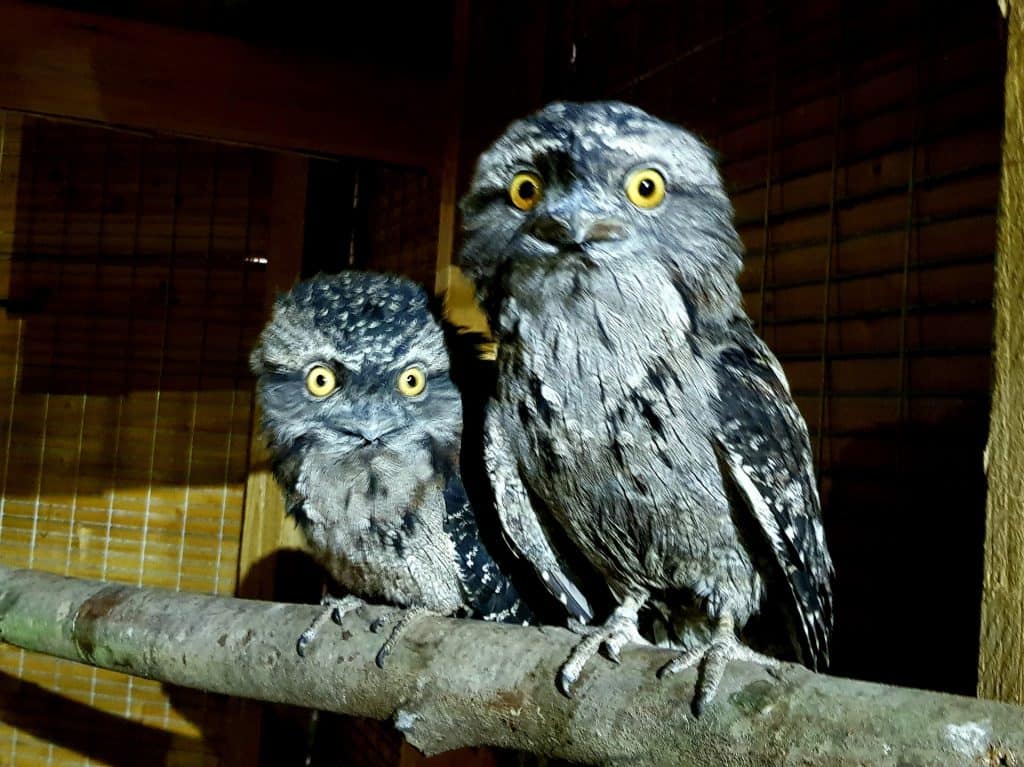This summer we’ve been very excited to open the doors to our new nocturnal house. This enclosure is super interesting as the day and night cycles have been swapped around. Previously if you tried to get a glimpse of our Frogmouths you may have struggled to spot one as they don’t move about too much during the day, but it’s been amazing watching them in their new exhibit as we can now view them when they are more active!

So, I thought this would be the perfect opportunity to introduce you to our two Tawny Frogmouths (Podargus strigoides) and tell you a little bit about this curious species. Our female Tango and male Furby both came to the park in February 2021 from Sandwich Wildlife Park, which is sadly in the process of closing now. I fell in love with these bizarre looking birds as soon as they arrived and it didn’t take long to see that they both had big personalities.
Telling the tawnies apart
Furby is noticeably bigger than Tango, but if you get a up close look, Tango has a little dimple in her eyelids when her eyes are closed. They are both very confident and very food motivated, but I would probably say Furby is a bit nosier than Tango, who loses interest in us pretty quickly once the food has gone.

But, what are they?
Frogmouths are just so cool. At first, they look a bit like a cross between an owl and a nightjar, with their large heads and big forward-facing eyes, but in fact they are in their own family the Podargidae. In reality, they are more closely related to owlet-nightjars, swifts and hummingbirds rather than owls. There are fourteen species of Frogmouths around the world, though some argue that there are 16, all of which are distributed in the Indomalaya and Australasia regions. Often thought of as nocturnal because they are more active at night, it is believed that they actually have short alternating patterns of sleep and wakefulness of about two hours at a time.
More research is needed on this for sure! During the day they often roost in an upright position, adopting a camouflaged posture when disturbed where they suck their body feathers in, elongate their body and neck whilst shutting their eyes. They seem to just become part of the tree branch when they do this. I just love it when they are relaxed as they completely transform into adorable fluffballs!

In the wild you can find Tawny Frogmouths in Australia, including much of Tasmania. Locally they are often referred to as a “Mopoke”, a name shared with the Boobook Owl, and other names include the Freckled Frogmouth, Night Hawk and Short Winged Podargus.
Habitats
They can be found in a range of habitats from eucalyptus forest, woodlands and shrublands and use trees and shrubs along rivers, coasts, roadways, farms, large gardens, and parks. They are a very adaptable species and can go into torpor for short periods of time during colder spells where they are able to reduce their metabolism and body temperature to cope with the cooler conditions.
What do they eat?
In the wild they would eat various large insects such as cockroaches, beetles, and moths as well as scorpions, spiders, centipedes, and frogs. They occasionally eat earthworms, snails, slugs, crustaceans, lizards, small birds, and small mammals.
When a prey item is particularly big, or awkward to swallow, we often see them smacking the food onto their training table or branch, presumably to stun the prey or move it into an easier position to consume. I am fascinated by their mouths! When they open their gob, they expose this huge bright yellow gape. It is a wonderful opportunity to get a look at their tongue. It is often difficult to get a look at the inside of a bird’s mouth, but I always have a look at a bird’s tongue when the opportunity arises as the size and shape of the tongue varies so much between species.

Here at the park their diet consists of insects like locusts or cockroaches, as well as chopped up chick and mice which is also dusted with a calcium supplement once a week. Whilst they do have a powerful beak which they can use to crush and pulp prey, they essentially adopt a “sit and wait” approach when hunting. As well as snatching insects in mid-air, they collect food from branches and from the ground as well. Interestingly they don’t use their feet to manipulate food like a bird of prey, they only their bills. Tawny Frogmouths extract all the water they need from their food so do not come down to bodies of water to drink or bathe, although they do enjoy sitting out in the rain. Ours certainly seem to enjoy a spray!
Status and threats
Tawny Frogmouth numbers have never been estimated globally, but they are listed as Least Concern on the IUCN red list because of their extremely large range and stable population. They don’t have any substantial threats in the wild, but numbers can drop in local areas due to deforestation when no trees remain and when there are issues with their insect food through indirect poisoning in urban areas where cockroach, snail and rodent pests are being managed.
Road collisions are also a hazard when flying low. Feral cats, foxes, dogs, and pythons are the main predators of adults, but their eggs and young are preyed on by a number of birds as well as rodents, snakes and lizards.
Breeding and lifespans
A single pair will defend a territory in the breeding season and are thought to form life-long bonds, although their courtship displays in the wild aren’t well studied. Males and females look remarkably similar so to be sure a feather sample is usually the most reliable way to tell the gender via DNA testing.
Females typically lay between one and three eggs which take around 28-32 days to hatch. Interestingly, both sexes take it in turn to incubate the eggs with males almost always sitting on the eggs during the day, and the female usually takes the night shift. Chicks will then leave the nest around 27-32 days. Sadly, because the young hatch asynchronously, the smaller (younger) chicks sometimes fall to the ground. Their life expectancy in the wild is not very well known but in other zoos ten years seems to be a good average, with some individuals living up to 21 years old.
What noises do frogmouths make?
Tawny Frogmouths are a very vocal species, with males and females performing duets in the breeding season. Juveniles make croak-like calls when begging for food, and even though Tango and Furby are five years old, they still make these begging calls to us at feed times. It is difficult to stimulate the natural feeding behaviour of catching insects, so it is often necessary to hand-feed them in a zoo environment.
As you can see, our birds have no problems picking food up for themselves but also take food nicely by the hand as well, which is useful for when we reward them during training sessions. Other vocalisations we can hear are a neat “oom” call and a series of purring sounds as well.
They also have have a loud high pitched warning call if distressed but thankfully we don’t hear that unless one needs to be caught up for a vet check. Tango and Furby have extremely chilled personalities and are very good at training. We call them to the table at every feed to give them a good once over and health check. Our head of training, Georgia is working on scale training with them as well currently, as this is the best way to assess their condition. It is very hard to see if a bird is fat or a bit trim underneath all of that fluff!
I hope you enjoyed reading up about these impressive birds. My photos often come out super blurry after the day lamps go off, but if you have a decent lens, we would love to see your nighttime photos. Tag us on the usual socials @winghamwildlifepark and please remember that the animals in the Nocturnal House are extremely sensitive to bright light during their nighttime cycle, so please no flash photography or torches. Ta!




